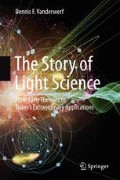Abstract
In 1851 Fizeau made an interferometric measurement to determine how the speed of light is affected in a moving medium [1]. The chosen medium was water, flowing at a velocity v of about 700 cm/s through the U-tube configuration shown in Fig. 3.1. Each tube section had a length ≈150 mm, with a tube diameter ≈5.3 cm. Light from a source is directed to a 50/50 beamsplitter and lens, where two collimated beams A and B entered the end of each tube. The light beams exited the other ends of the tubes, where they were focused to a flat mirror by a second lens. The reflected beams were then returned through the tubes and focused to a screen where they formed interference fringes, the path lengths of each beam being the same. Light beam A moved with the velocity of the water, while light beam B moved against the velocity of the water.
Access this chapter
Tax calculation will be finalised at checkout
Purchases are for personal use only
References
M.H. Fizeau, Sur les hypothèses relatives à l’éther lumineux. Annales de Chimie et de Physique III lvii, 385–404 (1859)
A. Michelson, E. Morley, Influence of motion of the medium on the velocity of light. Am. J. Sci. 31(185), 377–386 (1886). doi:10.2475/ajs.s3-31.185.377
A. Michelson, E. Morley, On the relative motion of the Earth and the luminiferous ether. Am. J. Sci. 234(203), 333–345 (1887). doi:10.2475/ajs.s3.203.333
N. Hamdan, Can the Lorentz-FitzGerald contraction hypothesis be real? Proc. Pak. Acad. Sci. 44(2), 121–128 (2007)
R. Serway, Physics for scientists and engineers/with modern physics (Holt, Rinehart and Winston, New York, 1983), pp. 839–841
A. Einstein, On the electrodynamics of moving bodies. Ann. Phys. 17, 891–921 (1905). doi:10.1002/andp.19053221004
A. Einstein, Does the inertia of a body depend on its energy content? Ann. Phys. 17, 639–641 (1905). doi:10.1002/andp.19052231314
R. Baierlein, E = mc2, in Newton to Einstein: The Trail of Light (Cambridge University Press, Cambridge, United Kingdom, 2002)
E. Fischbach et al., New geomagnetic limits on the photon mass and on long-range forces coexisting with electromagnetism. Phys. Rev. Lett. 73(4), 514–517 (1974). doi:10.1103/physRevLett.73.514
L.-C. Tu, J. Luo, G.T. Gillies, The mass of the photon. Rep. Prog. Phys. 68(1), 77–130 (2004). doi:10.1088/0034-4885/68/R02
A. Einstein, On the relativity principle and the conclusions drawn from it. Jahrbuch der Radioaktivität 4, 411–462 (1907)
A. Einstein, On the influence of gravitation on the propagation of light. Ann. Phys. 35, 898–908 (1911)
A. Einstein, Explanation of the perihelion motion of mercury from the general theory of relativity. Preussische Akademie der Wissenschaften, Sitzungsberichte, Part 2, 831–839 (1915)
R.J. Kennedy, E.M. Thorndike, Experimental establishment of the relativity of time. Phys. Rev. 42(3), 400–418 (1932). doi:10.1103/PhysRev.42.400
H. Ives, G. Stilwell, An experimental study of the rate of a moving atomic clock. J. Opt. Soc. Am. 28, 215–226 (1938). doi:10.1364/JOSA.28.000215
H. Ives, G. Stilwell, An experimental study of the rate of a moving atomic clock II. J. Opt. Soc. Am. 31, 369–374 (1941). doi:10.1364/JOSA.31.000369
D. Hasselkamp, E. Mondry, A. Scharmann, Direct observation of the transversal Doppler-shift. Zeitschrift für Physik A 289(2), 151–155 (1979). doi:10.1007/BF1435932
S. Reinhardt et al., Test of relativistic time dilation with fast optical atomic clocks at different velocities. Nat. Phys. 3, 861–864 (2007). doi:10.1038/nphys778
B. Rossi, D.B. Hall, Variation of the rate of decay of mesotrons with momentum. Phys. Rev. 59(3), 223–228 (1941). doi:10.1103/PhysRev.59.223
L. Liu, P. Solis, The speed and lifetime of cosmic ray muons. MIT Undergraduate Report, 18 Nov 2007
D.H. Frisch, J.H. Smith, Measurement of the relativistic time dilation using μ-mesons. Am. J. Phys. 31(5), 342–355 (1963). doi:10.1119/1.1969508
H. Bailey et al., Measurements of relativistic time dilatation for positive and negative muons in a circular orbit. Nature 268, 301–305 (1977). doi:10.1038/268301a0
J.C. Hafele, R.E. Keating, Around-the-world atomic clocks: predicted relativistic time gains. Science 177(4044), 166–168 (1972). doi:10.1126/science.177.4044.166
J.C. Hafele, R.E. Keating, Around-the-world atomic clocks: observed relativistic time gains. Science 177(4044), 168–170 (1972)
News from the National Physical Laboratory, Metronia, Issue 18, United Kingdom, Winter (2005)
F. Winterberg, Relativistische zeitdilatation eines künstlichen satelliten. Astronautica Acta 2(1), 25–29 (1956)
F.T. Trouton, A. Rankine, On the electrical resistance of moving matter. Proc. R. Soc. 80, 420 (1908). doi:10.1098/rspa.1908.0037
C. Sherwin, New experimental test of Lorentz’s theory of relativity. Phys. Rev. A 35(9), 3650–3654 (1987). doi:10.1103/PhysRevA.35.3650
F.W. Dyson, A.S. Eddington, C. Davidson, A determination of the deflection of light by the Sun’s gravitational field, from observations made at the total eclipse of 29 May 1919. Philos. Trans. R. Soc. Lond. 220A, 291–333 (1920). doi:10.1098/rsta.1920.0009
T. Alväger et al., Test of the second postulate of special relativity in the GeV region. Phys. Lett. 12(3), 260–262 (1964). doi:10.1016/0031-9163(64)91095-9
G.C. Babcock, T.G. Bergman, Determination of the constancy of the speed of light. J. Opt. Soc. Am. 54(2), 147–150 (1964). doi:10.1364/JOSA.54.000147
K. Brecher, Is the speed of light independent of the velocity of the source? Phys. Rev. Lett. 39(17), 1051–1054 (1977). doi:10.1103/PhysRevLett.39.1051
K. Brecher, Precision test of special relativity using gamma ray bursts. Bull. Am. Phys. Soc. 45(2), No. 34, May 2000 Meeting, Long Beach, California
Author information
Authors and Affiliations
Corresponding author
Rights and permissions
Copyright information
© 2017 Springer International Publishing AG
About this chapter
Cite this chapter
Vanderwerf, D.F. (2017). Light and Its Application to Relativity. In: The Story of Light Science. Springer, Cham. https://doi.org/10.1007/978-3-319-64316-8_3
Download citation
DOI: https://doi.org/10.1007/978-3-319-64316-8_3
Published:
Publisher Name: Springer, Cham
Print ISBN: 978-3-319-64315-1
Online ISBN: 978-3-319-64316-8
eBook Packages: Physics and AstronomyPhysics and Astronomy (R0)

